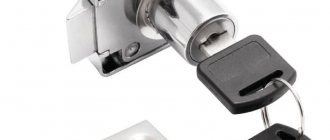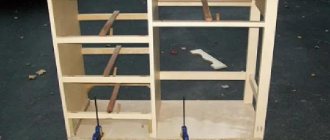You always want to make your bathroom as functional as possible, but at the same time leave some free space. Sound familiar? That is why planning and repairing it takes almost the most time. You need to choose plumbing fixtures and furniture to fit everything you need. Combined multifunctional solutions remain especially valuable. A striking example is the sink above the washing machine.
Benefits of the solution
The main and decisive advantage of installing a washbasin directly above the washing machine is space. The smaller the bathroom, the more relevant this is. After all, both objects are quite large, and it is impossible to do without both on the farm.
If everyone has long been accustomed to appliances built into cabinets and cabinets, then installing a sink above a washing machine is not the most obvious option. Therefore, we have selected several examples and are ready to share their secrets.
The variety of washbasin models is now such that there is an option for any interior. There are also many installation methods, so you can certainly choose something for yourself.
Disadvantages and difficulties
Before installing a sink above a washing machine, be sure to familiarize yourself with the possible pitfalls. There are only a few, but they are important.
The first problem is the most obvious: the wrong choice of location. Calculate all the distances down to the millimeter and carefully consider whether it will be comfortable for you. So that you don’t end up with literally nowhere to turn around in the bathroom.
A more serious problem is directly related to the combination of plumbing and electrical appliances. If you don’t have experience, trust the installation to professionals, because it’s about safety. And a short circuit is not the worst possible consequence.
The most difficult thing is to choose a siphon. But this can also be solved! Take a closer look at the special sinks that are already sold complete with it and are designed for just such an installation.
Also keep in mind that the water from the sink will drain worse than with a regular vertical drain. This means you will have to carefully use and design the system in such a way as to avoid stagnation.
Choosing a washing machine
Only front-loading machines are suitable for the washbasin. Vertical a priori make joint installation impossible.
Now there are special models that are sold ready for simultaneous installation. If you want to buy a regular machine or keep your own, carefully calculate all the dimensions. Especially the height.
The recommended height is up to 70 cm. In this case, a medium-depth washbasin is just convenient to use. The width of the machine is 40-45 cm. There are enough mini-models in stores with a load of a couple of kilograms. Do not forget that there should be a distance between the sink and the surface of the equipment - at least a few centimeters.
There is one more trick: the accompanying documentation for washbasins for joint installation indicates which models of washing machines they can be combined with.
Semicircular shape
Semicircular and oval washbasins will fit well into the bathroom if your goal is to smooth out rough corners or protect a small child from household injuries .
The streamlined shape makes the room safer. TOP 2 models of this type.
#1
Sink 62 cm Water Lily Lux-Light
A model that was specially created taking into account the characteristics of small apartments.
An elegant washbasin that allows you to place a washing machine underneath, thereby optimizing the space.
It is distinguished from other models by its special shape, which creates the illusion of weightlessness. This washbasin model was designed specifically for installation above washing machines in small bathrooms.
Specifications:
- Installation: wall.
- Shape: rounded.
- White color.
- Material: sanitary ware/porcelain.
- Equipment: brackets with siphon.
- Number of finished holes for the mixer: 1.
- Mixer location: in the center.
- Dimensions (width, height, depth): 62/14/60 cm.
Advantages
- Suitable for the smallest bathrooms.
- There is a siphon included.
- Good value for money.
- Original design.
Flaws
- You cannot get close to the sink due to its location.
- May not be suitable for those who plan to place items for washing and brushing teeth on the sides of the sink.
- It is better to use the help of a specialist during installation.
#2
Sink 61 cm Water Lily Light
Provides a harmonious combination of appliances and plumbing that will look great in any interior, both in the bathroom and in the kitchen.
Thanks to its special shape, it looks light and compact in any interior, without causing a feeling of clutter.
The drain is designed in accordance with European standards, which helps to avoid short circuits due to accidental leakage.
Can be installed above any narrow front-loading washing machine.
Specifications:
- Installation: wall.
- Shape: rounded.
- White color.
- Material: faience.
- Equipment: siphon, brackets, fasteners.
- Number of finished holes for the mixer: 0.
- Mixer location: in the center.
- Dimensions (width, height, depth): 61/14/60 cm.
Advantages
- Smooth and nice shapes.
- The kit contains everything needed for installation.
- Good quality faience.
- Easily washed to remove typical household stains.
Flaws
- Can only be used with a reversible mixer.
- Few places to find in stock.
- High price compared to analogues.
Sink selection
When combining a sink with a washing machine, it is important to find a balance between convenience and safety. For example, water lilies that are too flat are as compact as possible, but the water in them stagnates and splashes. And sinks that are too voluminous and deep simply cannot be placed comfortably on a washing machine whose height is not adjustable.
Dimensions
The recommended depth of sinks above the washing machine is from 17 to 20 cm. But calculate the length and width so that the washbasin protrudes beyond the edges of the equipment by at least 2-3 cm. This reserve is needed to prevent water from getting on the electrical equipment.
Materials
A classic solution when the sink material is combined with the rest of the plumbing. However, modern eclectic fashion allows for different options.
Glass sinks are stylish and unusual, but not the most reliable or convenient. They are easy to break, and when used, water stains always remain.
Earthenware is a more budget-friendly alternative to porcelain. This is a simple and practical solution, but over time, small cracks and stains appear on the surface. The top layer of glaze will inevitably wear out.
Porcelain is elegant and durable, but these sinks are heavy, making them awkward to install on a washing machine.
Natural stone is even heavier than porcelain, and is often significantly more expensive. It is better to use such washbasins as an independent design element.
Artificial stone is an excellent alternative. For example, cast marble made of polymer concrete with aggregates. It is lighter, more practical, easier to process, more unpretentious and cheaper, and in appearance it is almost no different from natural.
Overfill protection
When installing a sink on electrical equipment, it is important to protect the equipment from water. Therefore, install only washbasins with a drain-overflow system on washing machines.
A special side hole drains water if there is too much water. The most modern models work automatically.
Drain
Washbasins use two types of drains: vertical or horizontal.
Vertical is more efficient, it drains water faster and prevents it from stagnating. Horizontal is more compact and takes up less space in height. Just it can be taken to the side, and not lowered directly. It's safer, but be prepared to clean the drain regularly.
Please note that during the spin cycle the machine vibrates and moves, so you should not allow it to come into direct contact with the pipeline. This is the sure way to a breakthrough.
Which sink is suitable and what to pay attention to
In addition to the appropriate machine model, you will need to choose the right sink. One of the most popular models is the “Water Lily” sink. It is a small structure with a rectangular, semicircular, square or corner shape, which is intended for rooms with limited free space.
This type of plumbing may have an offset drain and a countertop under the sink. The dimensions of the sink are selected taking into account the specifics of the room. If the bathroom is spacious enough, the use of large structures with good depth is allowed.
Depending on the type of water drainage, the following varieties of “Water Lilies” are distinguished:
- with side shower;
- with vertical drain;
- with horizontal drain.
The latest models are in demand when combining a sink with a washing machine, but they have the following disadvantages:
- with horizontal drainage, the likelihood of pipe clogging becomes high;
- the speed of water passage is reduced;
- choosing a siphon can take a lot of time, because... choosing the optimal design can be difficult.
Classic products with a vertical drain type are more convenient, but they are not suitable for installation above a washing machine, because... Leaked liquid may end up on electrical wiring and cause a short circuit.
Water lily sinks rarely come with a faucet hole. You have to arrange it yourself.
The materials used to make “Water Lilies” are ceramics, vinyl, or polymer concrete (cast marble). Products made from cast marble are most in demand because... they have a lot of advantages. First of all, these are: a large selection of colors and textures, affordable prices and increased resistance to heavy loads. These models are also much lighter than ceramic ones.
Installing a sink above a washing machine
With joint installation, it would be more accurate to say that the machine is pushed under the sink, and not the washbasin is placed on it. In any case, first - all the construction work. And only then – electrical appliances!
Stability of the structure
The first and most important limitation is a perfectly flat floor. Otherwise, it is not recommended to install a sink above the washing machine. Level out all defects and height differences in advance.
Due to the close proximity to water supplies, it is necessary that the machine does not “fidget” too much. To do this, place a special rubber mat under it. It will not allow it to move even at high speeds, and at the same time it absorbs well.
If you use one faucet for the bathtub and sink, check that the spout moves freely and does not flood the floor of the machine. Otherwise, choose a washbasin with a small countertop or such a width that it extends over the side of the bathtub.
Sink mount
Before installing new brackets, mark the wall. To do this, place the bowl and draw everything under it. Otherwise, incorrectly drilled holes will not be able to be quietly repaired without cosmetic repairs.
At first, do not overtighten or screw in the bolts all the way to the head. Leave a free edge of about 0.5 cm. The sink with a siphon is mounted on brackets. The bowl is held in place by a metal hook. On one side it is inserted into a special hole, and on the other it is fixed in the wall.
Treat the protrusions, junctions and cracks with polyurethane foam. And only after sealing and installing the bowl can you screw in the mounting screws until they stop.
Mixer
It is best if the pipes to the mixer were initially removed into the wall or decorative structure. For connection, use special flexible hoses. They differ in size, thickness and configuration.
A tee will help separate the water flow to the faucet and washing machine. Select it according to the diameter and material of the pipeline.
Installation sequence
Preparatory activities
At the first stage, a washing machine is installed in the space cleared of unnecessary items and the sink is fitted to the wall. If it is not possible to install the bowl on the old brackets, then they are dismantled and the places for new fastenings are marked. We remind you that you should maintain a distance of 2–3 cm between the lid of the washing unit and the bottom surface of the sink. If a vertical drain is used, then this gap is measured from the siphon.
In addition, if it is necessary to conceal the wiring of utility lines, mark the places where they will be laid. After this, the washing machine is moved to the side, a hole is prepared in the wall for dowel fastenings, channels are grooved if necessary, and pipelines are installed.
Mixer installation
The mixer is installed using the copper fasteners included in the kit. Subsequently, this will allow you to easily dismantle the device for repair or replacement.
If the design of the sink includes a mixer, then it is installed before the product is installed in place. First, connect flexible supply hoses to the valve, making sure that their rubber O-rings are intact. After this, the device is installed in a special hole in the bowl, having previously placed a fluoroplastic gasket under it from the supply kit. Thanks to it, a tight fit of the bottom of the faucet to the sink is ensured, as well as protection of the smooth surface from scratches. On the reverse side, a segment washer is installed on the fastening screw and, using copper nuts from the set, the faucet is securely fixed to the bowl.
Siphon assembly and installation
When assembling the siphon, you should use the manufacturer's instructions. It is important to ensure a reliable fit of all parts of the part and good tightness. It will not be superfluous to lubricate all sealing gaskets with silicone sealant before installation. After assembly, the siphon is installed on the sink, after which the overflow system is installed, if provided for by the design. The last step is to connect a corrugated hose to the drain system. It is best secured using a threaded clamp.
Instructions for installing and connecting the sink
- Dowels are driven into the prepared holes and the brackets supplied are mounted. It is important not to tighten the fasteners until the washbasin is properly adjusted.
- Having installed the sink in place, control and, if necessary, adjust its horizontal level. If the longitudinal displacement of the structure is prevented by a special hook, then a corresponding mark is made on the wall.
- The washbasin is removed and the nuts securing the brackets to the wall are tightened.
- A layer of sealant is applied to the metal surfaces of the parts to protect the sanitaryware from damage.
- According to the mark on the wall, a hole is drilled into which an anchor or dowel is installed and a fastening hook is mounted.
- A layer of silicone sealant is applied where the back surface of the bowl meets the wall.
- The sink is installed on the prepared brackets. At the same time, it is important to monitor its fixation on the hook.
- The washbasin drain is connected to the sewer pipe, and the flexible connection is connected to the hot and cold water pipelines.
After checking the functionality of the mixer and the absence of leaks in the drain system, the washing machine is moved closer to the sink and connected to the water supply and sewer pipe. After this, the equipment is installed in place, not forgetting to adjust the horizontal position.
How to install a washing machine
After connecting and checking the sink and mixer, carefully push the washing machine into the resulting niche. Did you manage to hide communications in the wall? Then you can safely place the equipment close to it.
The last step is to strengthen the connections with a clamp. It will prevent unexpected thread breakage during pressure surges, increased flow rates and intensive draining. Before use, check the seal again. Ready!
Sink above the washing machine - photo
And to make it easier for you to make your choice and understand what a sink above a washing machine looks like in a real interior, we have selected different photos. Compare installation methods, evaluate their convenience and confidently choose the option for your bathroom!
Advantages and disadvantages of water lily shells
All types of washbasins have certain advantages and disadvantages. Among the advantages of water lily shells are the following:
- Compactness. Such designs are compact, thanks to which it is possible to save free space in the bathroom.
- Variety of shapes. Water lily shells differ in their shape. Therefore, everyone will be able to purchase a suitable type of sink for their bathroom.
- Easy to care for. It is very easy to care for water lily shells, as dirt does not accumulate on them.
The disadvantages of water lilies include:
- Non-standard siphon shape. It should be included with the sink, as it is not easy to purchase separately.
- Rapid clogging. The water lily drains back, and therefore the drain often becomes clogged.
- Sprinkling water. When using such a washbasin, water quickly splashes out, and because of this, drops can fall on the surface of the washing machine.











